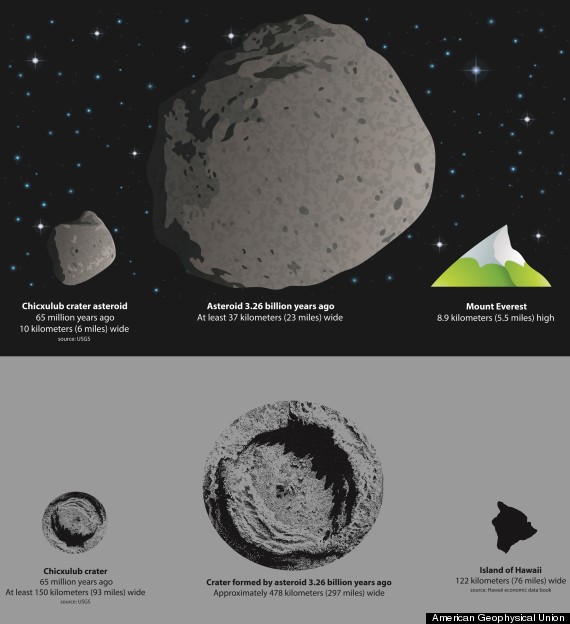Scientists believe that a huge asteroid smashed into Earth 65 million years ago, wiping out the dinosaurs. But if that errant space rock was a whopper, it was a pipsqueak compared to an asteroid that scientists now say slammed into Earth 3.26 billion years ago. That one caused the oceans to boil and shook the entire planet for half an hour.
“We knew it was big, but we didn’t know how big," Dr. Donald Lowe, a Stanford University geologist who conducted new research to model the catastrophic asteroid impact, said in a written statement. The colossal space rock--estimated to be at least 23 miles in diameter--was likely one of many that struck Earth between three and four billion years ago, during an era scientists call the Late Heavy Bombardment.
Story continues below.

A graphical representation of the asteroid thought to have killed the dinosaurs, and the crater it created, compared to an asteroid thought to have hit Earth 3.26 billion years ago and the size of the crater it likely generated.
Thanks to erosion and movements of the Earth's crust, the craters punched into Earth's surface by those billion-year-old asteroids are gone.
“We can’t go to the impact sites," Lowe said in the statement. "In order to better understand how big it was and its effect we need studies like this."
Lowe and a colleague looked at rock formations in the Barberton greenstone belt, a large area in eastern South Africa that contains some of the world's oldest rocks. The rocks are covered in a layer of spherules--tiny, spherical particles created when vaporized rock cast into the atmosphere by ancient asteroid impacts rained back down onto the planet's surface. The researchers calculated the asteroid's size based on the thickness and chemical composition of the spherules. Then they modeled the impact itself.
In addition to yielding the likely size of the asteroid, the calculations showed that it hit our planet at a speed of 44,000 miles an hour (20 kilometers per second). The impact created seismic waves akin to a 10.8 magnitude earthquake, raising ocean temperatures, setting off enormous tsunamis, and leaving an impact crater measuring 300 miles in diameter. That's greater than the distance between New York City and Washington, D.C.
Pretty amazing, for sure. But the scientists say their findings help refine our ideas about ancient asteroid impacts and how they affected conditions on a young Earth.
“This is providing significant support for the idea that the impact may have been responsible for this major shift in tectonics,” Frank Kyte, a UCLA geologist who was not involved in the study, said in the statement.
The research is to be published in the journal Geochemistry, Geophysics, Geosystems.
